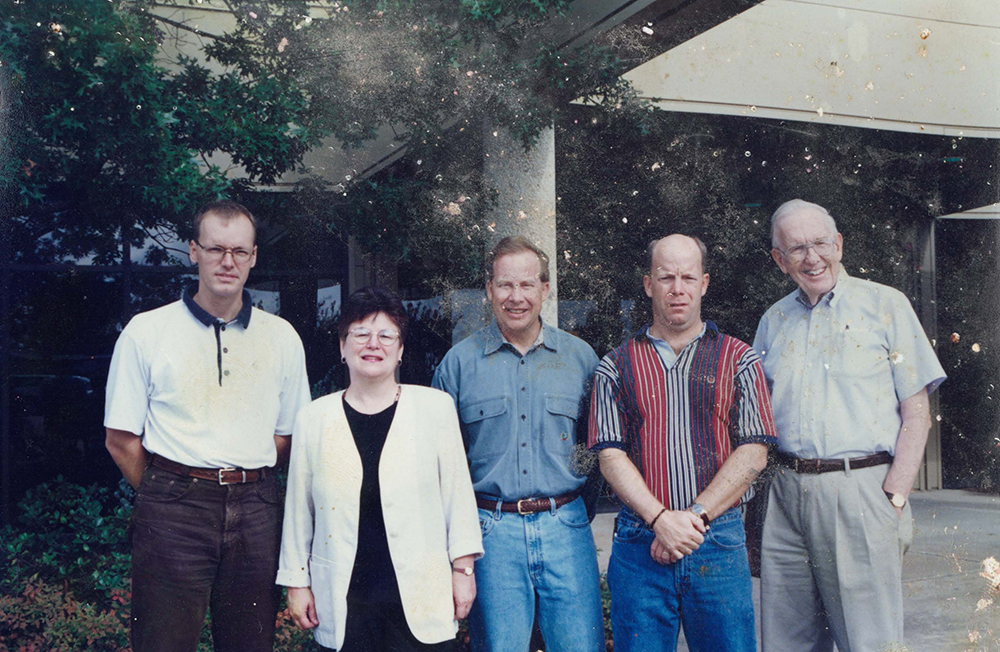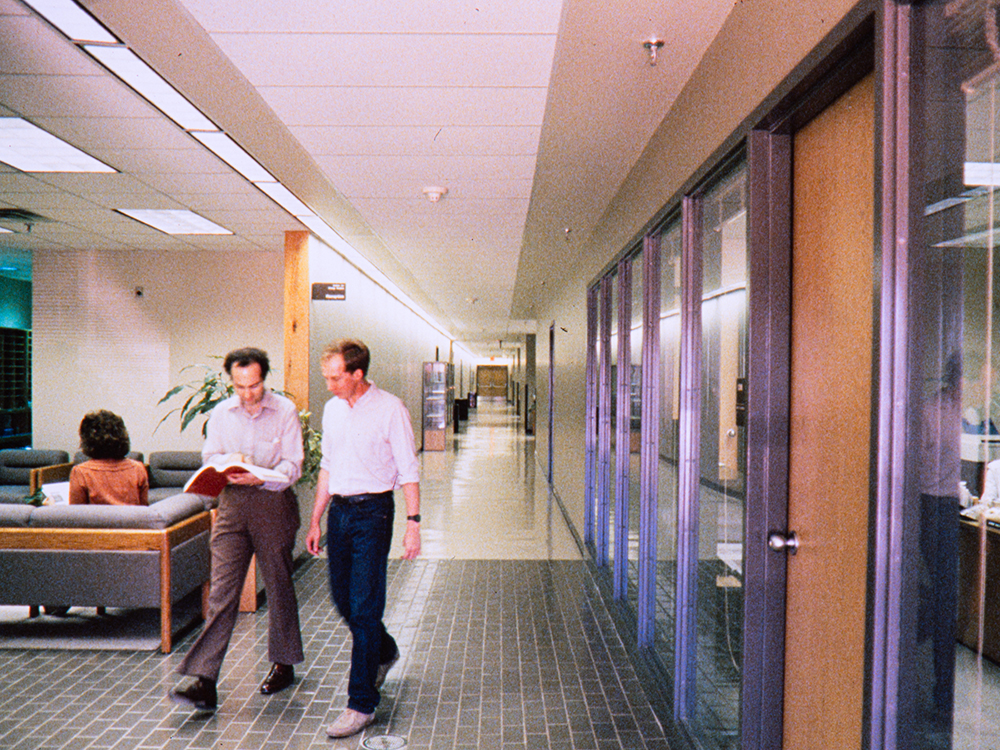
Dr. Frank Seibert will retire this year after almost 40 years of working in the Separations Research Program. Frank grew up in Houston TX, where he received his bachelor’s degree in chemical engineering in 1982 from the University of Houston. He attended the University of Texas for graduate school and received his master’s in 1984 and Ph.D. in 1986 in chemical engineering. Frank started off his graduate studies in a building called Schoch Labs, off Speedway, which was the original chemical engineering building on campus. When the building started to be evacuated for renovation, some of the students went to the new building, which at the time was the chemical and petroleum engineering, but some students went to the newly built Balcones Research Center. Frank was one of the first students at the newly established Center for Energy Studies.
Frank worked under the supervision of Dr. James R. Fair and Dr. Jimmy L. Humphrey. Frank and other graduate students learned early on that Dr. Fair was well known and well-respected in his field, “We always called him Dr. Fair; he was oftentimes referenced so we knew we were working for a legend.” Dr. Jimmy Humphrey had come from industry, working for Texas Eastman in Longview for many years and then for Argonne National Lab. In 1982 the Center for Energy Studies hired him so that he could look into the efficiency of chemical and petrochemical engineering.
One of the reasons that Dr. Fair and Dr. Humphrey started working together was because of Frank, who was being funded at the time by an organization called EPRI, Electric Power Research Institute. Frank recalls that, “Dr. Humphrey, Dr. Fair and I would have our research meetings usually once a week or every two weeks, and that's important because many of those meetings we didn't always talk about my research. They talked about forming this industrial consortium collaboration, so that's kind of how a lot of things evolved.” The Separations Research Program was formed in 1984, but they had a kickoff trial meeting in 1983 where they invited a lot of folks. Because the sponsors knew that students were involved in separations, they asked to see a student presentation, so Frank ended up being the first student to present his work in front of sponsors.
Dr. Fair and Dr. Humphrey had discussed the possibility of having pilot plant equipment installed as part of the building, so Dr. Fair and the director of the center, Dr. Herbert Woodson, went to the Board of Regents. The Board of Regents agreed and once it was approved, they had to find a program manager to oversee the construction of the pilot plant and the building. They recruited Dr. Jose Luis Bravo, who had been one of Dr. Fair's first graduate students. When Jose graduated, he worked for S&B Engineers, a design and construction company located in Houston, TX. Jose gladly accepted the position, and he joined the SRP in 1984. Around the same time, a Department of Energy project started looking at evaluating different separation options and they made Jose the manager of that project. Jose had two different projects: managing the pilot plant design and construction and managing the DOE project. As Frank was finishing his master’s degree, he and other graduate students named Chris Martin and Sudhir Joshi worked together with Jose on the DOE project.

Frank worked with Jose in the mornings and in the afternoons worked on his Ph.D. project. He was able to complete his Ph.D. in two years. Dr. Fair, Dr. Humphrey and Jose Bravo all played a key role in Frank’s professional development, “all three of these individuals are chemical engineering legends so I’m extremely blessed.”
The SRP has had good continual techical support over the years. Frank recalls seeing all the new equipment and asking Jose who was going to run it. In 1986 Jose found Bobby Reeves, who had taken early retirement from Texaco Chemicals in Austin TX. Bobby Reeves was the first SRP technician, working with SRP for about 10 years. Bobby knew all the tricks and could fix things when they weren't working properly. The company that had constructed the pilot plant still had some residual employees on site and one of those was Robert Montgomery, who has worked with SRP since the early days. Robert has enjoyed his work with the SRP, noting that his work typically consists of taking something that starts off in a box, connecting it to the Delta V computer where it communicates and then starting to see values, which he finds satisfying. Frank remembers other notable technicians fondly: "we've had technicians come and go, such as Joe Snyder, who was with us after Bobby retired. After Joe another important one was Steve Briggs, who was in the nuclear Navy. He was a submariner and outstanding, and he was a big help when we were going through a lot of changes at the pilot plant."
Frank also recalls the funding challenges of sustaining the SRP: "The university had been generous in providing the pilot plant capital equipment; however, the university provided no money for operations or maintenance. That would have to be on the SRP, but the consortium did not have money to support that. Jose Bravo only had one option to find money and that was to make the brand-new equipment available. They approached the consortium members and said we got this new equipment would you want to utilize it to support projects? That business model still exists today, as the majority of SRP’s funding comes from industry."
SRP has had many collaborators at UT over the years: Frank has worked with Gary Rochelle since 1991; he also worked with Kerry Kinney who worked in Environmental Engineering. Working with Kerry got him to start working with Professor Lynn Katz, and also Mary Jo Kurtz. It is important to note that the pilot plant in its operation has worked with other researchers in mechanical engineering and with other professors in the chemical engineering department. They’ve also had projects with the biology department. They have worked with almost all the technical disciplines at UT in one way or another.
Dr. Bruce Eldridge, who is currently the head of the Process, Science and Technology Center, was also one of the first students at the Center for Energy Studies at the Balcones Research Center. Having received his B.S. and M.S. from the University of Arkansas, Bruce started his Ph.D. studies at UT in January 1984. Frank was close to finishing his master’s degree when he first met Bruce: “Bruce had previously worked at Phillips 66 in Oklahoma, and he came as a graduate student. Because of his industrial background, Dr. Fair wanted to get him onboard. Bruce and I both worked in extraction, so we got to work together and help one other. We were literally the first two students in this new building.”
After Bruce graduated, he left UT and worked for nine years at Phillips Petroleum Co. but would end up returning to the University of Texas when the search for Dr. Fair’s replacement was underway. Dr. Fair was ready to retire, and SRP had to find someone to replace him. Frank stressed the point that the person who replaced Dr. Fair came from industry because the person needed to have the industrial perspective: “Dr. Fair, Jimmy Humphrey and Jose Bravo all had the industrial background. If you have a business that's supposed to be catering to industry, it's way better for everyone involved to have that industrial background. I kept pushing this and I brought up Bruce because of his unique perspective. Bruce had been an industrial sponsor representative for a few years and had that aspect background and obviously knew industrial separations.”
Bruce returned to UT in June 1996 in his new role as head of the Separations Research Program. Around that time, many of SRP’s sponsors were starting to merge. If they had 35 companies and five or six started to merge, that meant that they automatically lost sponsors. In addition, SRP started hearing from the sponsors that they wanted more accountability for their funding, and Bruce heard that loud and clear. Bruce appropriately decided to start doing that and ultimately this led to reorganizing and renaming the program from Separations Research Program to Process Science and Technology Center. Because of the name change, Bruce also tried to bring other process technologies and not just separations, but in the end, it seems like everything stayed separations.
Frank Seibert has been in his position for 38 years, and graduate student for four years, adding up to 42 years: “I don't know anybody who's been in one location for 42 years.” There are two particular highlights of his career: one, is that a lot of his work has been used by industry, which is something that he appreciates: “In a lot of university settings, you don't get that opportunity. You do the first step but there's got to be other steps that have to follow you, so you never get to see them but here almost all of our projects, the end result is not very long afterwards; it actually gets implemented in industry." The other reason is the students: "That's why we're here. The University of Texas probably has the best chemical engineering students out there. I’m not 100% sure why that is, but that's my impression when I see presentations at conferences. It's interesting how we're able to attract such talented people. I’ve watched students grow and improve...you always see them at the end of their program, and you're proud of them, that part I really like as well. I also learn from the students because they bring new questions and new perspectives, and they'll educate you on new technologies faster than you'll learn it on your own.”

